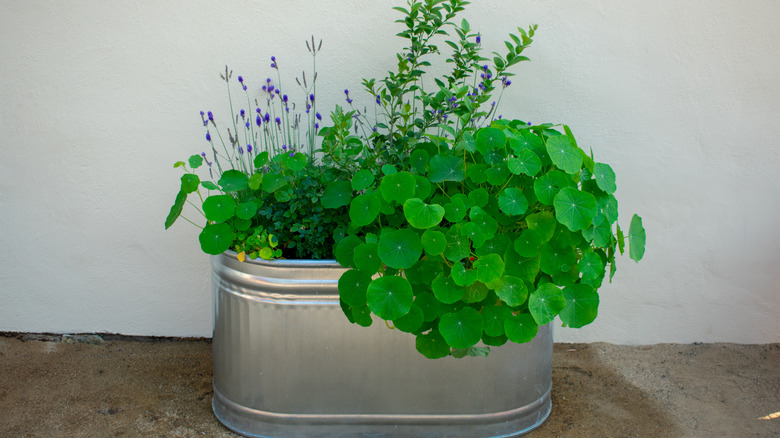Design Expert Reveals How To Turn Stock Tanks Into Wicking Garden Beds
If you're still digging into the ground to put in a garden, it's time you discover the joy of using stock tanks as raised garden beds. The sturdy galvanized aluminum tanks are used by farmers to feed and water livestock and come in a variety of shapes and sizes, and choosing the right size raised bed should be one of the first steps in your planning process. Designer Liz Marie Galvan used elongated troughs that she already owned, noting in her recent Instagram post that the animals she has needed lower tanks so she was keen on finding another use for the stock tanks they already owned.
With a little auto primer and some paint (which Galvan stressed was totally optional), the raised beds became a spiffy addition to her greenhouse area. The concept is an easy one to recreate in any home garden, big or small, country or city. The social media video shows the process of priming, painting, prepping, and planting the troughs, but the end result is a raised bed with a rather ingenious feature — Galvan and her husband drilled a hole big enough to include a hose, which allows watering and drainage, providing the wicking element to this garden bed.
Wicking function helps provide the perfect amount of water
Galvan's system for watering the plants in her stock tank and then wicking away the excess water via a PVC pipe that she inserted into the tank looks easy when viewing it on Instagram, but there were quite a few steps involved even if you decided to skip the primer and paint. As the design expert explained in her commentary, drainage holes are a must. In a departure from typical recommendations on how to prepare a livestock trough as a raised garden bed, Galvan and her husband lined their tanks with drainage tiles before laying PVC pipes across the bottoms of the tanks, finishing their handiwork by having a PVC pipe jut out the side of the tank.
The expectation is that excess water from rains or overzealous watering will collect at the bottom of the raised bed and get siphoned away without doing harm to plants that don't appreciate soggy roots. Galvan tops her pipes with a layer of gravel followed by landscape fabric before adding soil. The plants go in next, and with proper care, there should be bountiful crops and easy gardening for years to come.
